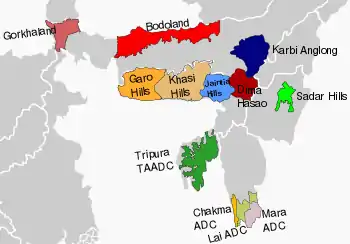Tripura Tribal Areas Autonomous District Council
The Tripura Tribal Areas Autonomous District Council (TTAADC) is an autonomous district council administering the Tripuri-dominated areas of the state of Tripura, India. Its council and assembly are situated in Khumulwng, a town 26 km away from Agartala, the state capital.
Tripura Tribal Areas Autonomous District Council | |
|---|---|
 | |
| Type | |
| Type | |
Term limits | 5 years |
| Leadership | |
Chairman | Vacant (Governor's rule) [1] |
Chief executive member | Vacant (Governor's rule) [2] |
| Structure | |
| Seats | 30 MDCs |
Political groups |
|
| Elections | |
| 28 plurality voting | |
| 2 nominated by Governor of Tripura | |
Last election | 2015 elections |
| Meeting place | |
 Council Headquarters, Khumulwng | |
| Website | |
| http://ttaadc.gov.in/ | |

In the 2005 elections to the TTAADC the Left Front won 24 seats out of the 28 elected seats and the Indigenous Nationalist Party of Twipra four. The Left Front and INPT had contested within the framework of an electoral understanding.[3]
The term of the previous council ended on 17 May 2020 and following the postponement of elections for a result of the global COVID-19 pandemic, TTAADC is currently under Governor's rule until a new council can be elected.[4][5]
The TTAADC is set to be renamed the Tipra Territorial Council (TTC), as part of a general reorganization which will also expand the council's powers and increase the number of seats on it from 28 elected and 2 appointed to 44 elected and 6 appointed.[6][7]
Formation
The Tripura Tribal Areas Autonomous District Council (TTAADC) Act 1979 was passed by the Indian parliament after a series of democratic movements launched by the Indigenous people of Tripura, under the provision of the 6th scheduled of the Indian constitution. The principal objective behind setting up the autonomous district council is to empower the Indigenous people to govern themselves and also to bring all round developments of the backward people so as to protect and preserve their culture, customs, and traditions. But it actually came into being on 15 January 1982 and elected members were sworn in on 18 January 1982. Later, it was upgraded under the provision of the 6th schedule of the Indian constitution by the 49th constitution (Amendment) act, 1984; with effect from 1 April 1985.
Total area
The total area of the TTAADC is 7,132.56 km2., which covers about 68% of the total area (10,491 km2) of the state.
About 70% of land under TTAADC is covered by hilly forest, whereas all the plain cultivable land including all the districts and sub-divisional headquarters are outside the purview of.[8]
Population
Total population of 3,673,917 of the State (as per 2011 census) the total population of Scheduled Tribes is 853,920 (30.95%), out of which about 679,720 (79.59%) population are within the TTAADC area.[9]
The total population of Tripura was 3,191,168 according to 2001 census.
Council
The TTAADC is governed by a council which has 30 members. Out of 30 members, 28 members are elected through adult suffrage, while 2 members are nominated by the governor of Tripura. Out of 28 elected seats, 25 are reserved for Scheduled Tribes.
Executive committee
TTAADC has a regular administrative structure. Executive committee composed of 10 members and chief executive officer (CEO) is the head of the administration.
Powers
Under the Sixth Schedule of the Constitution, the Tripura Tribal Areas Autonomous District Council is vested with two types of Powers. These are 1. legislative powers and 2. executive powers.
Legislative
The Legislative Department of the district council is headed by the chairman, who summons the meeting of the council from time to time in connection with approval of budget, discussion on bills, rules and regulations submitted by the treasury bench and passing of the same thereof.
The council consists of 30 members, out of which 28 members are elected by adult franchise and 2 members are nominated by the governor of Tripura.
The chairman has his own secretariat headed by the secretary to the district council.
Executive
The executive powers are vested with the executive committee, which is headed by the chief executive member, who is elected from among the Treasury Bench members.
The Sixth Schedule to the Constitution of India provides ample powers to the district council for self-Governance of the tribal population of the state. The district council has its own powers to appoint its own staff in terms of requirement and appointment rules. The council administration is headed by the chief executive officer and a deputy chief executive officer of TCS Grade-I and 6 executive officers, such as administration, finance, rural development, planning, development, and coordination, etc.
Relationship with Panchayat
Before the establishment of the district council, villages included in its jurisdiction had Gram panchayats like the rest of the state. Following the establishment of the council, Tripura Panchayat Raj Act ceased to operate in that area and there was no village level body- elected or otherwise. In 2006, the State Government decided to hold elections to the Village Councils by treating them on par with village Panchayats in other parts of the State taking the view that nothing in Sixth Schedule precludes such a course of action. The Autonomous Council is, however, as of 2009, yet to transfer any functions to these newly established Councils.[10]
Rural Development Blocks within TTAADC
West Tripura district
- Lefunga
- Hezamara
- Jampuijola
- Mandwi
- Mungiakami
- Padmabil
- Tulashikhor
- Bishramganj Amtali/Gulaghati
North Tripura district
- Damcherra
- Jampui Hill
- Pecharthal[†]
- Dasda
South Tripura district
- Ompinagar
- Killa
- Korbuk
- Rupaichhori
Dhalai district
- Chhawmanu
- Manu
- Dumburnagar
- Salema
- Ambassa
- Ganganagar
- Raisyabari
^† (Pecharthal RD Block was created bifurcating the Dasda RD Block on 28 November 1994. At that time this block consisted of 22 (Twenty Two) Nos. ADC Villages. On 1 April 1999, this block was again bifurcated and Damcherra RD Block was created comprising 9 (Nine) Nos. ADC Villages. Thereafter, Pecharthal RD Block consisted of 13 Nos. ADC Villages and again 1 (One) ADC Village namely Joymanipara ADC Village has been excluded from Pecharthal RD Block in recent re-organization of District and Sub-Divisions. At present, Pecharthal RD Block consists of 12 (Twelve) Nos. of ADC Villages under Kumarghat Sub-Division, Unakoti District (w.e.f. 01-01-2012 ). The Block area is mainly dominated by Chakma Tribes, other Sub-Tribes found in this Block area are Reang, Tripuri and Darlong community.)
See also
Citation
- "Ex CS, GK Rao to be appointed as the Chief Administered to TTAADC". tripurainfo.com. Retrieved 18 May 2020.
- "Tripura ADC executive committee to be dissolved on May 17, Guv will hold charge till next polls". The Indian Express. 12 May 2020. Retrieved 18 May 2020.
- "Historic Victory Of The Left Front". People's Democracy. 20 March 2005.
- Deb Barman, Priyanka; Hussain, Sabir (12 May 2020). "Tripura to dissolve autonomous district councils as polls could not be held". Hindustan Times. Retrieved 18 May 2020.
- "TTAADC executive council to be dissolved on May 17: Nath". Outlook India. PTI. Retrieved 18 May 2020.
- "The Tripura Tribal Areas Autonomous District Council to get a new name". The Sentinel. 19 December 2020. Retrieved 2 February 2021.
- "Tripura tribal council to get a new name". The Hindu. 19 December 2020. Retrieved 2 February 2021.
- TTAADC basic statestics
- Basic Statestics
- "State and District Administration: Fifteenth Report" (PDF). Second Administrative Reforms Commission, Government of India. April 2009. p. 267. Archived from the original (PDF) on 10 March 2016.
External links
| Wikimedia Commons has media related to Tripura Tribal Areas Autonomous District Council. |